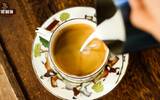Can I put a thermos in a thermos pot to keep my coffee warm? Why does coffee not taste so good after it cools down? What is the most suitable amount of milk for latte?
Finally! Under the wash of the cold air, Qianjie finally felt the coolness of autumn in Guangzhou. Although it is said to last for a short time, it is still better than nothing.

As Qianjie often shares, the drop in temperature will have a certain impact on coffee. This impact is not only on the extraction, but also on the coffee produced. When the coffee is brewed, the temperature will drop faster than in a normal temperature environment, because the greater the temperature difference, the faster the temperature will be lost. Too fast cooling can shorten the taste period of coffee, because it is well known that hot coffee will not taste as good after cooling down. Many friends cannot finish a cup of coffee in a short period of time, so this has led many merchants to study how to extend the "taste period" of coffee, that is, to make the coffee cool more slowly.

Obviously, raising the temperature of the coffee is a good way! As long as we appropriately increase the temperature of the liquid when making coffee, for example, using hotter hot water to make a hotter hot American style and using hotter milk to make a hotter hot latte, the coffee can have a higher temperature and the taste period is therefore extended. Not only that, it can also reduce the impact of cold air on some coffee extraction. For example, Qianjie often shares hand-made coffee.
Because hand-brewed coffee is manually controlled to inject water into the kettle to extract coffee, hot water will come into contact with a certain amount of air before extracting coffee, and this will cause the temperature of the hot water to drop to a certain extent. Especially when the weather is colder, the temperature will drop more, so the brewed coffee often does not have such a full flavor due to the reduction in extraction efficiency. In this case, we can appropriately increase the water temperature used during brewing, offset the impact of cold air, and restore the taste of the brewed coffee.
However, some friends misunderstood this approach because they greatly increased the temperature in order to allow the coffee to maintain a high temperature for a longer period of time. This practice is not advisable for most coffees, especially the hand-brewed coffee and intentional milk coffee mentioned earlier. Without adjusting other parameters, a large increase in water temperature will easily break out a cup of coffee with obvious bitter and miscellaneous flavors. Because the water temperature is directly related to the extraction efficiency, the higher the extraction efficiency, the faster the coffee flavor substances dissolve during the brewing process. Not all soluble substances in coffee are pleasing flavor substances, but some are debris that can make coffee less delicious. Therefore, without adjusting other parameters, rashly raising the water temperature significantly will easily overdraw the coffee.
Next is milk coffee! Qianjie often shares that it is best to control the milk temperature when making hot milk coffee to around 65°C. Not only because this temperature range can activate the lactose sweetness of milk and make the milk taste better, but also because once it exceeds 70°C, some substances in the milk will begin to denature, which will reduce the sweetness and taste. Become weak. Therefore, when making hot milk coffee, the temperature of the milk is usually controlled at around 65°C, and the highest is more than 70°C. If the temperature rises further, it will cause obvious and irreversible negative effects on the coffee.
For these two types of coffee, it is recommended to increase the temperature slightly based on the original, so that it will not affect the extraction of coffee and the texture of coffee. For example, hand-brewed coffee increases the water temperature by 1 to 2°C based on the original water temperature; the milk of Italian milk coffee increases the water temperature by 3 to 4°C based on the original water temperature. In addition, we can also use some other ways to keep coffee high for a long time.
1. Preheating the container The temperature of the container itself will also affect the temperature of the coffee. Similarly, heat will transfer from places with high temperatures to places with low temperatures. If the utensils in contact with coffee are not preheated, they will draw a large amount of temperature from the coffee to replenish themselves. Take the former street as an example! Qianjie once experimented making coffee without preheating the filter cup or coffee pot, and the temperature of the coffee that finally fell on the lower pot was around 65°C. If these utensils are preheated, the final coffee temperature will be around 75°C.
So preheating utensils is a good way to keep warm! Preheat the utensils you want to use in the coffee maker, or blanch them with hot water before serving coffee ~
2. Put a lid on the coffee For containers equipped with a lid such as a sharing pot, we can physically reduce the flow of air by putting the lid on, so that the temperature of the coffee will not lose too quickly. At the same time, it also allows the aroma of coffee to remain for a longer time.
Qianjie once conducted such an experiment, using thermos bottles to store hot hand-brewed coffee. It turns out that the better the sealing effect of the container, the longer the temperature and aroma of the coffee can remain. So if you are an individual player, you can choose to use a thermos bottle to hold hand-brewed coffee. When you are not drinking, you can screw on the lid to seal it. The temperature and aroma of the coffee will remain for a long time.
But it should not be left for too long. After all, coffee is not pure water and there is a risk of bacteria breeding. It is best to drink it within about 2 to 3 hours.
- END -
Important Notice :
前街咖啡 FrontStreet Coffee has moved to new addredd:
FrontStreet Coffee Address: 315,Donghua East Road,GuangZhou
Tel:020 38364473
- Prev

How to make coffee cream? Do I have to use instant powder for 400 hand-made coffee? What is the composition of coffee cream in Naples coffee?
Some time ago, Qianjie shared with you a relatively alternative coffee making, namely "coffee cream", also known as "foam coffee." Just by blowing air into the coffee by stirring, you can give the coffee a creamy silky texture and soft taste. And this is not the first time Qianjie has shared it,
- Next

Children suffocated and died after drinking pearl milk tea! Parents: The store did not inform the risk
▲ Click to pay attention| Daily Boutique Coffee Culture Magazine Coffee Factory Recently, terms such as "Three-year-old child drinks pearl milk tea" and "Store responds that boy suffocated after drinking pearl milk tea" have hit the hot searches on Weibo, arousing widespread attention and discussion from all walks of life. Jiupai News, Zhongan Online and other media reported the cause of the incident
Related
- Being chased out of the rain in front of Starbucks?! Store: Sheltering from rain under umbrellas poses a safety hazard
- The white moonlight has changed?! Lucky launches "Big Winter Pear American"
- Hand-brewed coffee three-stage method, high-sweet and universal brewing method to share! What does the high sweet water level of hand-brewed coffee mean?
- What is the difference between raw, refined and full espresso coffee? How to extract espresso and taste good?
- A complete list of coffee bean names and their meanings! What is Yejia Shefi coffee? Where is Mantelin coffee?
- What grade does Arida Manor Kaduai coffee beans belong to? What treatment is Arida ASD slow anaerobic sun exposure?
- The milk tea cup becomes smaller?! Overlord Tea Girl launches a new "Return to Yunnan" series
- Accused of selling counterfeit and high-priced coffee beans! Well-known boutique coffee brand "Oukelao" bowed and apologized!
- How to make espresso dumplings? Can I eat coffee and glutinous rice balls together?
- Save the unformed and stagnant powder cakes in one second! What is the problem with stagnant water in the powder bowl of the espresso machine?

